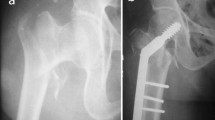Abstract
Background
Intertrochanteric fractures are commonly encountered in day-to-day trauma practice having various fracture patterns. Adequate reduction and appropriate fixation methodology is required for optimum results. However, failure rates are very high in unstable fractures. Here we describe a unique unstable variant of intertrochanteric fracture characterized by a long spike of proximal fragment, irreducibility of fracture with standard traction and internal rotation and soft tissue interposition. This appears as typical figure of 3 signs on right side and epsilon ε sign on left side on AP X-ray of pelvis with both hips.
Materials and methods
In retrospective review of 924 intertrochanteric fractures treated at our institution from June 2005 to January 2017, twenty patients with this typical highly unstable fracture pattern (epsilon sign/figure of 3 at fracture site) were operated at our institution, which included 18 males and two females with average age of 43.5 years (range 30–60 years). All patients required open reduction with specific maneuver and dynamic hip screw fixation.
Results
All patients had good reduction at the end of surgery, and all patients had good signs of clinico-radiological union at follow-up. None of the patients had implant loosening or screw back out.
Conclusion
The typical radiological pattern seen on X-ray will guide the surgeon to predict this unstable variant of IT fracture preoperatively and will suggest toward requirement of open reduction with specific maneuver and internal fixation with dynamic hip screw.








Similar content being viewed by others
References
Haijing H, Jingyi X, Baotong M (2014) Analysis of complications of intertrochanteric fracture treated with Gamma 3 intramedullary nail. Int J Clin Exp Med 7:3687–3693
Cyril J, Shishir SM, Syed N (2016) Type II intertrochanteric fractures: proximal femoral nailing (PFN) versus dynamic hip screw (DHS). Arch Bone Jt Surg 4:23–28
Pervez H, Parker MJ, Pryor GA, Lutchman L, Chirodian N (2002) Classification of trochanteric fracture of the proximal femur: a study of the reliability of current systems. Injury 33:713–715
Kulkarni GS, Limaye R, Kulkarni M, Kulkarni S (2006) Intertrochanteric fractures. Indian J Orthop 40:16–23
Bannister GC, Gibson AG, Ackroyd CE, Newman JH (1990) The closed reduction of trochanteric fractures. J Bone Jt Surg Br 72:317
Jeffrey AG, Comron S, Todd AM, William M (2010) Tip-apex distance of intramedullary devices as a predictor of cut-out failure in the treatment of peritrochanteric elderly hip fractures. Int Orthop 34:719–722
Adam P (2014) Treatment of recent trochanteric fracture in adults. Orthop Traumatol Surg Res 100:S75–S83
Said GZ, Farouk O, Said HGZ (2005) An irreducible variant of intertrochanteric fractures: a technique for open reduction. Int J Care Injured 36:871–874
Author information
Authors and Affiliations
Contributions
RC—orthopedic surgeon, performed all the surgeries, NM—orthopedic surgeon, done the data collection and interpretation, AJ—orthopedic surgeon, done the data collection and interpretation, RA—orthopedic surgeon, done the data collection and interpretation, MS—orthopedic surgeon, done the data collection and interpretation and AK—orthopedic surgeon, done the data collection and interpretation.
Corresponding author
Ethics declarations
Conflict of interest
The authors declare that they have no conflict of interest.
Ethical approval
The article does not contain any studies with human participants or animals performed by any authors.
Additional information
Publisher's Note
Springer Nature remains neutral with regard to jurisdictional claims in published maps and institutional affiliations.
Rights and permissions
About this article
Cite this article
Chandak, R., Malewar, N., Jangle, A. et al. Description of new “epsilon sign” and its significance in reduction in highly unstable variant of intertrochanteric fracture. Eur J Orthop Surg Traumatol 29, 1435–1439 (2019). https://doi.org/10.1007/s00590-019-02478-4
Received:
Accepted:
Published:
Issue Date:
DOI: https://doi.org/10.1007/s00590-019-02478-4




